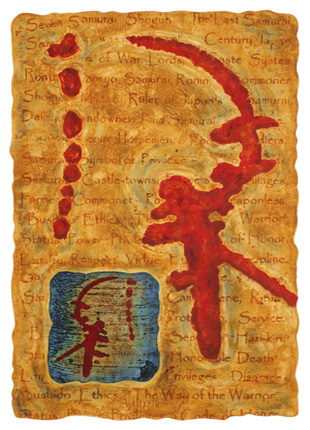Because very little land was good for farming in Japan, wars over land [...]]]>
Because very little land was good for farming in Japan, wars over land ownership influenced the rise of the Samurai. In the feudal system, Samurai or “those who serve” were subject to a lord or daimyo, and were very devoted in their support.
Bushido or “The Way of the Warrior” was an important unwritten code of conduct for the Samurai. Seven Virtues of the Bushido Code were: Rectitude, Courage, Benevolence, Respect , Honesty, Honor, and Loyalty. Freedom from fear, duty, discipline, morality, self sacrifice, and sometimes vengeance were also common traits of the Samurai. Many of these codes are still practiced today in modern martial arts.
The Samurai used lots of different swords. The Katana sword was a curved blade sword. In my Arborglyph monoprint below, I used an aspen tree bark marking that vaguely resembles a Samurai figure with the Katana sword. You also see seven circular shapes that could represent the Seven Virtues of the Bushido Code. Text in the background reiterates the various attributes of the Samurai and their codes.
The Seven Samurai, a classic 1954 Japanese movie by Akira Kurosawa, was a favorite of mine in college and it influenced not only my artwork, but endless other famous movies and Spaghetti Westerns. Again… the number Seven!
